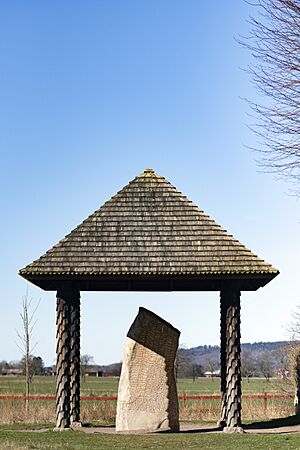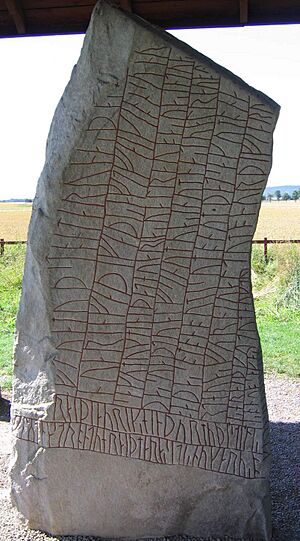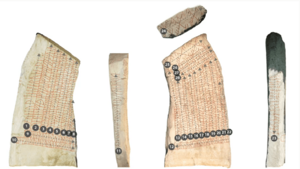Rök runestone facts for kids
Quick facts for kids Rök runestone |
|
|---|---|

The stone under its protection roof in 2020.
|
|
| Height | 2.4 m (8 feet) |
| Weight | 5.1 tons |
| Writing | Younger Futhark |
| Created | 800 |
| Discovered | 19th century Rök, Östergötland, Sweden |
| Present location | Rök, Ödeshög Municipality, Östergötland, Sweden |
| Culture | Norse |
| Rundata ID | Ög 136 |
| Style | RAK |
| Runemaster | Varinn |
| Text – Native | |
| Old Norse: See article. | |
| Translation | |
| See article. | |
The Rök runestone (Swedish: Rökstenen; Ög 136) is a very famous stone with ancient writing called runes. It has the longest runic message ever found carved into a stone! You can find it next to a church in a village called Rök in Sweden. Many people think it's the first piece of written Swedish literature. This means it marks the start of Sweden's written history.
Contents
About the Rök Runestone
This huge stone weighs about 5.1 tons (that's like a small elephant!) and stands 2.4 meters (8 feet) tall. It was found in the 1800s built right into the wall of a church. The church was built way back in the 1100s. It was common in those days to use old runestones as building materials. The Rök runestone was probably carved in the early 800s. We know this from the type of runes used and the language style.
The stone has runes carved on five of its sides. Only the bottom part, which was meant to be buried, doesn't have writing. Some parts of the writing are a bit damaged, but most of it can still be read.
The name "Rök Stone" is a bit funny. The stone is named after the village "Rök." But the village itself might have been named after the stone! In the old language, "Rauk" or "Rök" meant a "skittle-shaped stone."
This stone is special for many reasons. It has a small part of what might be a lost story from Norse mythology. It also mentions a real historical figure, Theodoric the Great, who was a powerful king long ago. The Rök runestone has the longest runic message from before Christianity came to Sweden, with about 760 characters. It shows how skilled the carver was at writing with runes.
The message on the stone is a bit like a puzzle. Some parts are written in code, using special cipher runes or by moving letters around. It's meant to be hard to read! It uses clever word puzzles called kennings, which were common in old Norse poetry. This shows the carver knew many different ways to write. Some people even think the difficult writing might have been part of a magic ritual.
In 2015, some experts suggested that the message isn't about old heroes at all. They think it's a series of riddles about how the stone itself was made.
What the Runestone Says

Here is what the Rök runestone says, translated into English. Most researchers agree on how to read the runes. However, what the message really means is still a big mystery and people have different ideas.
In memory of Vámóðr stand these runes. And Varinn coloured them, the father, in memory of his dead son.
I say the folktale / to the young men, which the two war-booties were, which twelve times were taken as war-booty, both together from various men.
I say this second, who nine generations ago lost his life with the Hreidgoths; and died with them for his guilt.
Þjóðríkr the bold,
chief of sea-warriors,
ruled over the shores
of the Hreiðsea.
Now he sits armed on
§B his Goth(ic horse),
his shield strapped,
the prince of the Mærings.
§C I say this the twelfth, where the horse of Gunnr sees fodder on the battlefield, where twenty kings lie.
This I say as thirteenth, which twenty kings sat on Sjólund for four winters, of four names, born of four brothers:
five Valkis, sons of Ráðulfr,
five Hreiðulfrs, sons of Rugulfr,
five Háisl, sons of Hǫrðr,
five Gunnmundrs/Kynmundrs, sons of Bjǫrn.
Now I say the tales in full. Someone …
I say the folktale / to the young men, which of the line of Ingold was repaid by a wife's sacrifice.
I say the folktale / to the young men, to whom is born a relative, to a valiant man. It is Vélinn. He could crush a giant. It is Vélinn …
§D I say the folktale / to the young men: Þórr.
§E Sibbi of Vé, §C nonagenarian, begot (a son).
The Theodoric Strophe
One part of the runestone's message talks about a famous king named Theodoric. This section is called the "Theodoric strophe." It describes him as a brave leader who ruled over the shores of the Hreiðsea. It says he now sits ready on his Gothic horse, with his shield strapped on. This part of the inscription is very important because it connects the stone to a real historical figure from a long time ago.
Theories About the Stone's Purpose
Many different ideas have been suggested about why the Rök runestone was made and what its message truly means. Here are some of the main theories:
- A Father's Tribute: One idea is that Varinn, the carver, made the stone just to honor his son who had died. The stories and myths included were simply a way to show his love and respect. This theory is supported by the fact that the god Thor is mentioned, which was a common way to ask for protection on graves before Christianity arrived.
- A Call for Revenge: Another theory suggests that Varinn carved the stone to encourage his tribe to get revenge for his son's death. The dramatic battle mentioned in the text might have been where his son died.
- Preserving Old Stories: Some believe Varinn was a "thul," a special storyteller for his clan. He might have feared that the old tribal myths would be lost after his son's death. So, he carved them onto the stone in a short form to make sure they would be remembered.
- Showing Power: The stone might have been a way for the tribe's leader to show how important and powerful he was. By listing a long line of strong ancestors, he could prove his right to lead. The stone was so big and noticeable that everyone passing by would see it.
- Connecting to a Famous Battle: The part of the stone that mentions "twenty kings" lying on a battlefield has been linked to the Battle of Brávellir. This was a legendary battle in Norse mythology that supposedly happened not far from where the Rök stone stands.
- A Sacrifice Theory: One interesting idea suggests that Varinn was a local chief who performed sacrifices to the gods. When a Christian missionary named Ansgar arrived and baptized his son's wife, Varinn might have been forced to sacrifice his own son to the old gods. The text mentions "a wife's sacrifice," which could mean either a religious offering or a baptism. This theory suggests Varinn used the word "faigian" (meaning "soon to die") instead of "dauðan" (meaning "dead") because his son was still alive when the stone was carved, but destined to die.
- Climate Crisis Message: Recently, researchers from three Swedish universities suggested that the inscription is actually about a past climate crisis, like a "Fimbulwinter" (a very long, harsh winter from Norse mythology). They think it refers to extreme weather events that happened about 300 years before the stone was carved. These events included a powerful solar storm, a very cold summer, and a near-total solar eclipse. The theory is that the stone's message is a warning or a memory of these difficult times.
See also
 In Spanish: Piedra de Rök para niños
In Spanish: Piedra de Rök para niños
- List of runestones
- Rundata
Images for kids





